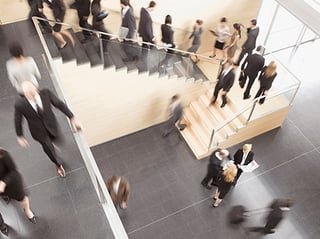As the manufacturer that offers the fullest range of physical security entrance products, Boon Edam has the ability to observe and interpret trends in buying behavior across a wide spectrum of vertical markets. In “More Security, From Bottom to Top”, we will share with you industry best practices we’ve observed in recent years in the hope that this may spur discussion, aid you in formulating future building security and implementation plans, and help with reducing workplace violence and active shooter incidents.
Security: More of What, Where?
Since 9/11, the demand for physical security entrances—turnstiles, security revolving doors and mantrap portals—has continued to grow across most, if not all, verticals. There has been continued, robust growth in the installation of turnstiles and security doors in Class A office buildings, corporate and government offices, and across all types of campus environments. Just about everywhere, building owners are gravitating towards expanded and more innovative physical security solutions. Yet, “More Security, From Bottom to Top” is not just about “more” …but rather, “more of what?” and “more of what, where?"
A Shift in the Security of a Typical Building Lobby
When you think of a Class A office building entrance, what do you envision? Most of us see the usual lobby, receptionist, possibly some security personnel. But is that still the case? Is that the entrance and lobby of the future? The answer, in our experience, is a resounding “no.”
What changes are coming about in the security levels on the ground floor? What about other floors? It’s a rather alarming thought, but once someone has navigated your lobby and entered the elevator, your entire building is now open to them and a potential threat for your organization. Too many tragic examples abound on the news of active shooter  scenarios and workplace violence incidents because someone managed to gain access to areas and people they should not have.
scenarios and workplace violence incidents because someone managed to gain access to areas and people they should not have.
Office Buildings are Implementing Higher Levels of Security
When we talk about the level of security, we’re referring to the ability to control movement by users in and out of secured areas. Basically, there are 3 levels of security: Low, monitoring or controlling traffic; Medium, tailgating and piggybacking detection; and High, tailgating/piggybacking prevention. These different levels of security have distinctly different mixes of technology, required personnel, and costs associated with each. How best to achieve the desired level of security, while ensuring a winning ROI? How can we mitigate physical violence opportunities, loss prevention risks, and provide superior evidence collection capabilities?
Our years of observation have led us to conclude that Class A office buildings are moving along the continuum to higher levels of security, but what does that look like—what mix of technology, personnel, and protocols, and, just as importantly, what’s the economic payoff for an increased level of security? Are there any potential downsides to a higher security level strategy implementation? The answer will surprise you.
Remember our vision of today’s entrance and lobby? For decades now, installations of doors and turnstiles have almost exclusively been on the ground floor of buildings—this is changing rapidly, but where and how are key questions we need to explore. Real market examples will help better explain how lobby security is changing and how security is moving deeper into our buildings.
It is clear that the demand for a high level of physical security is growing across multiple market segments – click below to receive our observations of how this is happening, what it looks like, and how you can benefit from our knowledge and recommendations!
